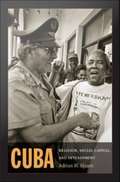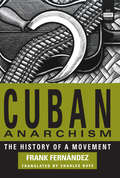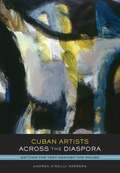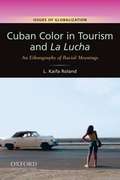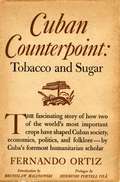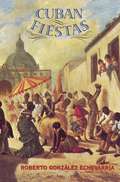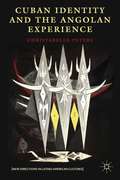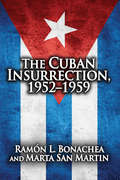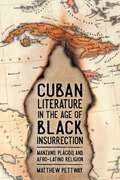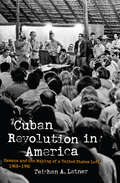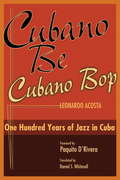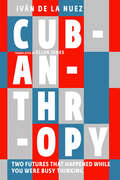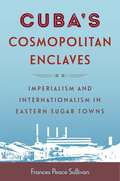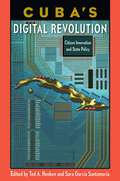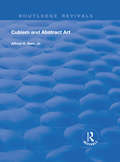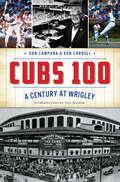- Table View
- List View
Cuba: Religion, Social Capital, and Development
by Adrian H. HearnWhen Cuba's centralized system for providing basic social services began to erode in the early 1990s, Christian and Afro-Cuban religious groups took on new social and political responsibilities. They began to work openly with state institutions on projects such as the promotion of Afro-Cuban heritage to encourage tourism, and community welfare initiatives to confront drug use, prostitution, and housing decay. In this rich ethnography, the anthropologist Adrian H. Hearn provides a detailed, on-the-ground analysis of how the Cuban state and local religious groups collaborate on community development projects and work with the many foreign development agencies operating in Cuba. Hearn argues that the growing number of collaborations between state and non-state actors has begun to consolidate the foundations of a civil society in Cuba. While conducting research, Hearn lived for one year each in two Santera temple-houses: one located in Old Havana and the other in Santiago de Cuba. During those stays he conducted numerous interviews: with the historian of Havana and the conservationist of Santiago de Cuba (officials roughly equivalent to mayors in the United States), acclaimed writers, influential leaders of Afro-Cuban religions, and many citizens involved in community development initiatives. Hearn draws on those interviews, his participant observation in the temple-houses, case studies, and archival research to convey the daily life experiences and motivations of religious practitioners, development workers, and politicians. Using the concept of social capital, he explains the state's desire to incorporate tightly knit religious groups into its community development projects, and he illuminates a fundamental challenge facing Cuba's religious communities: how to maintain their spiritual integrity and internal solidarity while participating in state-directed projects.
Cuban Anarchism: The History of a Movement
by Charles Bufe Frank FernándezThis inspiring history of the Cuban anarchist movement is also a history of the Cuban labor movement. It covers both from their origins in the mid-19th century to the present, and ends with an enlightening analysis of the failure of the Castro dictatorship.
Cuban Artists Across the Diaspora
by Andrea O'Reilly HerreraAn important contribution to both diasporic and transnational studies and discussions of contemporary Cuban art, Cuban Artists Across the Diaspora ultimately testifies to the fact that a long tradition of Cuban art is indeed flourishing outside the island.
Cuban Color in Tourism and La Lucha: An Ethnography of Racial Meanings
by L. Kaifa RolandThis book explores the tensions and contradictions of post-Soviet-era Cuba's use of tourism, a fundamentally capitalist tool, to sustain its socialist economy.
Cuban Connection: Nixon, Castro, and the Mob
by William Weyand TurnerIn April 1959, Fidel Castro toured the United States at the invitation of the American Society of Newspaper Editors. Though he was wary, Castro entertained some hope of establishing a rapprochement with Washington. But after being snubbed by President Eisenhower and receiving a less-than-cordial reception from Vice President Richard Nixon, Castro got the strong impression that US intentions toward his new Cuban government were hostile. In The Cuban Connection, former FBI agent and investigative journalist William Turner examines the fateful meeting between Castro and Nixon and the murky connections that existed between official Washington, the CIA, and organized crime in Cuba. Based on firsthand interviews with many of the key players involved in Cuban-American relations of that era, plus thorough background research, Turner raises a host of disturbing questions: Before the ouster of the Cuban dictator Fulgencio Batista by Castro, why did Vice President Nixon often socialize at Havana casinos with his Cuban friend Bebe Rebozo? How was the rabid anticommunism of the Eisenhower administration, especially its instant dislike of Castro, connected to its cozy relationship with the former mob-controlled dictatorship? How did all of this set the stage for the Bay of Pigs fiasco and ultimately the Cuban Missile Crisis and the JFK assassination? In a vivid narrative The Cuban Connection provides insider information that rarely reaches the public and that many in power never wanted the public to know.
Cuban Counterpoint: Tobacco and Sugar
by Fernando OrtizFirst published in 1940 and long out of print, Fernando Ortiz's classic work, Cuban Counterpoint is recognized as one of the most important books of Latin American and Caribbean intellectual history. Ortiz's examination of the impact of sugar and tobacco on Cuban society is unquestionably the cornerstone of Cuban studies and a key source for work on Caribbean culture generally. Though written over fifty years ago, Ortiz's study of the formation of a national culture in this region has significant implications for contemporary postcolonial studies. Ortiz presents his understanding of Cuban history in two complementary sections written in contrasting styles: a playful allegorical tale narrated as a counterpoint between tobacco and sugar and a historical analysis of their development as the central agricultural products of the Cuban economy. Treating tobacco and sugar both as agricultural commodities and as social characters in a historical process, he examines changes in their roles as the result of transculturation. His work shows how transculturation, a critical category Ortiz developed to grasp the complex transformation of cultures brought together in the crucible of colonial and imperial histories, can be used to illuminate not only the history of Cuba, but, more generally, that of America as well. This new edition includes an introductory essay by Fernando Coronil that provides a contrapuntal reading of the relationship between Ortiz's book and its original introduction by the renowned anthropologist Bronislaw Malinowski. Arguing for a distinction between theory production and canon formation, Coronil demonstrates the value of Ortiz's book for anthropology as well as Cuban, Caribbean, and Latin American studies, and shows Ortiz to be newly relevant to contemporary debates about modernity, postmodernism, and postcoloniality.
Cuban Cultural Heritage: A Rebel Past for a Revolutionary Nation (Cultural Heritage Studies)
by Pablo Alonso GonzálezThe role of cultural heritage and museums in constructing national identity in postcolonial CubaDuring Fidel Castro's rule, Cuban revolutionaries coopted and reinterpreted the previous bourgeois national narrative of Cuba, aligning it with revolutionary ideology through the use of heritage and public symbols. By changing uses of the past in the present, they were able to shift ideologies, power relations, epistemological conceptions, and economic contexts into the Cuba we know today.Cuban Cultural Heritage explores the role that cultural heritage and museums played in the construction of a national identity in postcolonial Cuba. Starting with independence from Spain in 1898 and moving through Cuban-American rapprochement in 2014, Pablo Alonso González illustrates how political and ideological shifts have influenced ideas about heritage and how, in turn, heritage has been used by different social actors to reiterate their status, spread new ideologies, and consolidate political regimes.Unveiling the connections between heritage, power, and ideology, Alonso González delves into the intricacies of Cuban history, covering key issues such as Cuba's cultural and political relationships with Spain, the United States, the Soviet Union, and so-called Third World countries; the complexities of Cuba's status as a postcolonial state; and the potential future paths of the Revolution in the years to come. This volume offers a detailed look at the function and place of cultural heritage under socialist states.A volume in the series Cultural Heritage Studies, edited by Paul A. ShackelPublication of the paperback edition made possible by a Sustaining the Humanities through the American Rescue Plan grant from the National Endowment for the Humanities.
Cuban Fiestas
by Roberto González EchevarríaIn the Cuban town of Sagua la Grande, a young Roberto Gonzalez Echevarria peers out the window of his family home on the morning of the Nochebuena fiesta as preparations begin for the slaughter of a feast day pig. The author recalls 'watching them at a distance, though thinking, fearing, that once I grew older I would have to participate in the whole event'. Now an acclaimed scholar of Latin American literature, Gonzalez Echevarria returns to the rituals that defined his young life in Cuban Fiestas. Drawing from art, literature, film, and even the national sport of baseball, he vividly reveals the fiesta as a dynamic force of both destruction and renewal in the life of a people. Roberto Gonzalez Echevarria masterfully exposes the distinctive elements of the fiesta cubana that give depth and coherence to more than two centuries of Cuban cultural life. Reaching back to nineteenth-century traditions of Cuban art and literature, and augmenting them, in the twentieth, with the arts of narrative, the aesthetic performances of sport and entertainment in nightclubs, on the baseball diamond, and in movie theatres, "Cuban Fiestas" renders the lilting strains of the fiesta and drum beats of the passage of time as keys to understanding the dynamic quality of Cuban culture. Gonzalez Echevarria's explorations are also illuminated by autobiographical vignettes that unveil the ever-shifting impact of the fiesta on the author's own story of exile and return.
Cuban Identity and the Angolan Experience
by Christabelle PetersExploring the cultural politics of Cuba's epic military engagement in the Angolan civil war, this book narrates the transformation of Cuban national identity from Latin African to Caribbean through the experience of internationalism in Angola.
Cuban Insurrection 1952-1959
by Ramon L. BonacheaThe Cuban Insurrection is an in-depth study of the first stage of the Cuban Revolution, the years from 1952 to 1959. The volume depicts the origins of the conflict, details the middle years, and ends with Fidel Castro's victorious arrival In Havana on January 8, 1959. Based on a wealth of hitherto unpublished original material, including confidential military reports, letters from various leaders of the insurrection and data gathered from interviews held In Cuba and abroad, the book Is a descriptive historical analysis of the struggle against military dictator Fulgencio Batista. The authors challenge the traditional premise that Cuba's insurrection began in the rural areas and only later expanded into urban areas. Instead they argue that the insurrectionary struggle was based upon combined urban-rural guerrilla warfare against the regular army. Basically, The Cuban Insurrection treats two major movements involved in the struggle—The Directorio Revolucionario and the M-26-7—and examines the growth, ideology, conflicts, and military strategies of their respective rural and urban organizations. The book includes a detailed analysis of combat, strikes, uprisings, and expeditions. Original maps and charts illustrate battles, maneuvers, and guerrilla political structures.
Cuban Literature in the Age of Black Insurrection: Manzano, Plácido, and Afro-Latino Religion (Caribbean Studies Series)
by Matthew PettwayJuan Francisco Manzano and Gabriel de la Concepción Valdés (Plácido) were perhaps the most important and innovative Cuban writers of African descent during the Spanish colonial era. Both nineteenth-century authors used Catholicism as a symbolic language for African-inspired spirituality. Likewise, Plácido and Manzano subverted the popular imagery of neoclassicism and Romanticism in order to envision black freedom in the tradition of the Haitian Revolution. Plácido and Manzano envisioned emancipation through the lens of African spirituality, a transformative moment in the history of Cuban letters. Matthew Pettway examines how the portrayal of African ideas of spirit and cosmos in otherwise conventional texts recur throughout early Cuban literature and became the basis for Manzano and Plácido’s antislavery philosophy. The portrayal of African-Atlantic religious ideas spurned the elite rationale that literature ought to be a barometer of highbrow cultural progress. Cuban debates about freedom and selfhood were never the exclusive domain of the white Creole elite. Pettway’s emphasis on African-inspired spirituality as a source of knowledge and a means to sacred authority for black Cuban writers deepens our understanding of Manzano and Plácido not as mere imitators but as aesthetic and political pioneers. As Pettway suggests, black Latin American authors did not abandon their African religious heritage to assimilate wholesale to the Catholic Church. By recognizing the wisdom of African ancestors, they procured power in the struggle for black liberation.
Cuban Memory Wars: Retrospective Politics in Revolution and Exile (Envisioning Cuba)
by Michael J. BustamanteFor many Cubans, Fidel Castro's Revolution represented deliverance from a legacy of inequality and national disappointment. For others—especially those exiled in the United States—Cuba's turn to socialism made the prerevolutionary period look like paradise lost. Michael J. Bustamante unsettles this familiar schism by excavating Cubans' contested memories of the Revolution's roots and results over its first twenty years. Cubans' battles over the past, he argues, not only defied simple political divisions; they also helped shape the course of Cuban history itself. As the Revolution unfolded, the struggle over historical memory was triangulated among revolutionary leaders in Havana, expatriate organizations in Miami, and average Cuban citizens. All Cubans leveraged the past in individual ways, but personal memories also collided with the Cuban state's efforts to institutionalize a singular version of the Revolution's story. Drawing on troves of archival materials, including visual media, Bustamante tracks the process of what he calls retrospective politics across the Florida Straits. In doing so, he drives Cuban history beyond the polarized vision seemingly set in stone today and raises the prospect of a more inclusive national narrative.
Cuban Privilege: The Making of Immigrant Inequality in America
by Susan Eva EcksteinFor over half a century the US granted Cubans, one of the largest immigrant groups in the country, unique entitlements. While other unauthorized immigrants faced detention, deportation, and no legal rights, Cuban immigrants were able to enter the country without authorization, and have access to welfare benefits and citizenship status. This book is the first to reveal the full range of entitlements granted to Cubans. Initially privileged to undermine the Castro-led revolution in the throes of the Cold War, one US President after another extended new entitlements, even in the post-Cold War era. Drawing on unseen archives, interviews, and survey data, Cuban Privilege highlights how Washington, in the process of privileging Cubans, transformed them from agents of US Cold War foreign policy into a politically powerful force influencing national policy. Comparing the exclusionary treatment of neighboring Haitians, the book discloses the racial and political biases embedded within US immigration policy.
Cuban Revelations: Behind the Scenes in Havana (Contemporary Cuba)
by Marc FrankIn Cuban Revelations, Marc Frank offers a first-hand account of daily life in Cuba at the turn of the twenty-first century, the start of a new and dramatic epoch for islanders and the Cuban diaspora. <p><p>A U.S.-born journalist who has called Havana home for almost a quarter century, Frank observed in person the best days of the revolution, the fall of the Soviet Bloc, the great depression of the 1990s, the stepping aside of Fidel Castro, and the reforms now being devised by his brother. <p><p>Examining the effects of U.S. policy toward Cuba, Frank analyzes why Cuba has entered an extraordinary, irreversible period of change and considers what the island's future holds. The enormous social engineering project taking place today under Raúl's leadership is fraught with many dangers, and Cuban Revelations follows the new leader's efforts to overcome bureaucratic resistance and the fears of a populace that stand in his way. <p><p>In addition, Frank offers a colorful chronicle of his travels across the island's many and varied provinces, sharing candid interviews with people from all walks of life. He takes the reader outside the capital to reveal how ordinary Cubans live and what they are thinking and feeling as fifty-year-old social and economic taboos are broken. He shares his honest and unbiased observations on extraordinary positive developments in social matters, like healthcare and education, as well as on the inefficiencies in the Cuban economy.
Cuban Revolution in America: Havana and the Making of a United States Left, 1968–1992 (Justice, Power, and Politics)
by Teishan A. LatnerCuba's grassroots revolution prevailed on America's doorstep in 1959, fueling intense interest within the multiracial American Left even as it provoked a backlash from the U.S. political establishment. In this groundbreaking book, historian Teishan A. Latner contends that in the era of decolonization, the Vietnam War, and Black Power, socialist Cuba claimed center stage for a generation of Americans who looked to the insurgent Third World for inspiration and political theory. As Americans studied the island's achievements in education, health care, and economic redistribution, Cubans in turn looked to U.S. leftists as collaborators in the global battle against inequality and allies in the nation's Cold War struggle with Washington. By forging ties with organizations such as the Venceremos Brigade, the Black Panther Party, and the Cuban American students of the Antonio Maceo Brigade, and by providing political asylum to activists such as Assata Shakur, Cuba became a durable global influence on the U.S. Left.Drawing from extensive archival and oral history research and declassified FBI and CIA documents, this is the first multidecade examination of the encounter between the Cuban Revolution and the U.S. Left after 1959. By analyzing Cuba's multifaceted impact on American radicalism, Latner contributes to a growing body of scholarship that has globalized the study of U.S. social justice movements.
Cuban Sugar Industry: Transnational Networks and Engineering Migrants in Mid-Nineteenth Century Cuba
by Jonathan Curry-MachadoNineteenth-century Cuba led the world in sugar manufacture and technological innovation was central to this. Through the story of a group of forgotten migrant workers who anonymously contributed to Cuba's development, this book explores the development of the Cuban sugar industry and how the country became bound into global networks.
Cuban Émigrés and Independence in the Nineteenth-Century Gulf World (Envisioning Cuba)
by Dalia Antonia MullerDuring the violent years of war marking Cuba's final push for independence from Spain, over 3,000 Cuban emigres, men and women, rich and poor, fled to Mexico. But more than a safe haven, Mexico was a key site, Dalia Antonia Muller argues, from which the expatriates helped launch a mobile and politically active Cuban diaspora around the Gulf of Mexico. Offering a new transnational vantage on Cuba's struggle for nationhood, Muller traces the stories of three hundred of these Cuban emigres and explores the impact of their lives of exile, service to the revolution and independence, and circum-Caribbean solidarities.While not large in number, the emigres excelled at community building, and their effectiveness in disseminating their political views across borders intensified their influence and inspired strong nationalistic sentiments across Latin America. Revealing that emigres' efforts were key to a Cuban Revolutionary Party program for courting Mexican popular and diplomatic support, Muller shows how the relationship also benefited Mexican causes. Cuban revolutionary aspirations resonated with Mexican students, journalists, and others alarmed by the violation of constitutional rights and the increasing conservatism of the Porfirio Diaz regime. Finally, Muller follows emigres' return to Cuba after the Spanish-American War, their lives in the new republic ineluctably shaped by their sojourn in Mexico.
Cubano Be, Cubano Bop: One Hundred Years of Jazz in Cuba
by Leonardo Acosta Daniel Whitesell Paquito D'RiveraBased on unprecedented research in Cuba, the direct testimony of scores of Cuban musicians, and the author's unique experience as a prominent jazz musician, Cubano Be, Cubano Bop is destined to take its place among the classics of jazz history. The work pays tribute not only to a distinguished lineage of Cuban jazz musicians and composers, but also to the rich musical exchanges between Cuban and American jazz throughout the twentieth century.The work begins with the first encounters between Cuban music and jazz around the turn of the last century. Acosta writes about the presence of Cuban musicians in New Orleans and the "Spanish tinge" in early jazz from the city, the formation and spread of the first jazz ensembles in Cuba, the big bands of the thirties, and the inception of "Latin jazz." He explores the evolution of Bebop, Feeling, and Mambo in the forties, leading to the explosion of Cubop or Afro-Cuban jazz and the innovations of the legendary musicians and composers Machito, Mario Bauzá, Dizzy Gillespie, and Chano Pozo. The work concludes with a new generation of Cuban jazz artists, including the Grammy award-winning musicians and composers Chucho Valdés and Paquito D'Rivera.
Cubanthropy: Two Futures That Happened While You Were Busy Thinking
by Iván de La NuezCuban art critic and curator Iván de la Nuez explores the effects of the policies that have tried to constrain or liberate Cuba in recent decades in these sparkling essays of cultural criticism.Essays on Cuba and the Cuban diaspora, on racism and Big Data, Guantánamo and Reggaeton, soccer and baseball, Obama and the Rolling Stones, Europe and Donald Trump—de la Nuez approaches his criticism with singularity of purpose. In Cubanthropy he does not set out to explain Cuba to the world, but rather to put the world into a Cuban context.&“Nothing explains our vexed world quite like Cuba and no one anywhere writes more brilliantly, more prophetically, more impossibly than Iván de la Nuez. As in all of his finest work, Cubanthropy delivers you beyond your old horizons into a realm of startling possibilities. Do not miss this extraordinary book or this extraordinary warlock of a writer.&” —Junot Díaz, author of This Is How You Lose Her&“Cubanthropy may just be the smartest writing on Cuba—and beyond—I&’ve read in ages. Insightful, unsparing, funny, and with an unerring eye for the paradoxical, Iván de la Nuez has written the definitive compilation on 21st-century Cuba. Essential reading for all who care about how the past, present, and future are disturbingly converging on the island, and off.&” —Cristina García, author of forthcoming Vanishing Maps
Cuba’s Cosmopolitan Enclaves: Imperialism and Internationalism in Eastern Sugar Towns (Caribbean Crossroads: Race, Identity, and Freedom Struggles)
by Frances Peace SullivanHow northeastern Cuba became a hub of international solidarity and transnational movements in the 1920s and 1930s This book explores how a region in Cuba that was widely known as a site of labor subjugation became a hub of international solidarity in the 1920s and 1930s. In the early twentieth century, United States agricultural companies like the United Fruit Company established sugar export operations in Cuba’s Oriente Province, creating a zone of economic imperialism. These early multinational corporations recruited Afro-Caribbean laborers from surrounding islands, aiming to create closed, self-sufficient plantation complexes. However, as Frances Peace Sullivan shows in Cuba’s Cosmopolitan Enclaves, the influx of foreign capital led to the development of diverse, vibrant communities in these company towns. Drawing on archival sources in Cuba, the US, Russia, and the UK, Sullivan demonstrates how immigrant workers joined local Cubans in movements for radical transnational solidarity. In the interwar years, northeastern Cuba became a center of Garveyite Pan-Africanism, global communism, and antifascist support for Republican Spain. In 1933, the region attracted the world’s attention when workers seized sugar mills in a revolutionary strike. Placing northeastern Cuba at the heart of the history of interwar internationalism, Sullivan shows how Oriente emerged as a focal point for visions of resistance. Cuba’s Cosmopolitan Enclaves reveals how workers seized pathways created by imperialist companies and used them to advance their own goals. In this focused study, Sullivan offers a detailed portrait of how ordinary people became leaders in transnational radicalism. A volume in the series Caribbean Crossroads: Race, Identity, and Freedom Struggles, edited by Lillian Guerra, Devyn Spence Benson, April Mayes, and Solsiree del Moral
Cuba’s Digital Revolution: Citizen Innovation and State Policy (Reframing Media, Technology, and Culture in Latin/o America)
by Ted A. Henken and Sara Garcia SantamariaA wide-ranging examination of the ways digital technologies are impacting Cuba’s Revolutionary project The triumph of the Cuban Revolution gave the Communist Party a monopoly over both politics and the mass media. However, with the subsequent global proliferation of new information and communication technologies, Cuban citizens have become active participants in the worldwide digital revolution. While the Cuban internet has long been characterized by censorship, high costs, slow speeds, and limited access, this volume argues that since 2013, technological developments have allowed for a fundamental reconfiguration of the cultural, economic, social, and political spheres of the Revolutionary project.The essays in this volume cover various transformations within this new digital revolution, examining both government-enabled paid public web access and creative workarounds that Cubans have designed to independently produce, distribute, and access digital content. Contributors trace how media ventures, entrepreneurship, online marketing, journalism, and cultural e-zines have been developing on the island alongside global technological and geopolitical changes.As Cuba continues to expand internet access and as citizens challenge state policies on the speed, breadth, and freedom of that access, Cuba’s Digital Revolution provides a fascinating example of the impact of technology in authoritarian states and transitional democracies. While the streets of Cuba may still belong to Castro’s Revolution, this volume argues that it is still unclear to whom Cuban cyberspace belongs. Contributors: Larry Press | Edel Lima Sarmiento | Olga Khrustaleva | Alexei Padilla Herrera | Eloy Viera Cañive | Marie Laure Geoffray | Ted A. Henken | Sara Garcia Santamaria | Anne Natvig | Carlos Manuel Rodríguez Arechavaleta | Mireya Márquez-Ramírez, Ph.D.| Abel Somohano Fernández | Rebecca Ogden | Jennifer Cearns | Walfrido Dorta | Paloma DuongA volume in the series Reframing Media, Technology, and Culture in Latin/o America, edited by Héctor Fernández L’Hoeste and Juan Carlos RodríguezPublication of the paperback edition made possible by a Sustaining the Humanities through the American Rescue Plan grant from the National Endowment for the Humanities.
Cuba’s Revolutionary World
by Jonathan C. BrownAs Castro’s democratic reform movement veered off course, a revolution that seemed to signal the death knell of dictatorship in Latin America brought about its tragic opposite. Jonathan C. Brown examines in forensic detail how the turmoil that rocked a small Caribbean nation in the 1950s became one of the century’s most transformative events.
Cubed: A Secret History of the Workplace
by Nikil SavalYou mean this place we go to five days a week has a history? Cubed reveals the unexplored yet surprising story of the places where most of the world's work—our work—gets done. From "Bartleby the Scrivener" to The Office, from the steno pool to the open-plan cubicle farm, Cubed is a fascinating, often funny, and sometimes disturbing anatomy of the white-collar world and how it came to be the way it is—and what it might become.<P> In the mid-nineteenth century clerks worked in small, dank spaces called “counting-houses.” These were all-male enclaves, where work was just paperwork. Most Americans considered clerks to be questionable dandies, who didn’t do “real work.” But the joke was on them: as the great historical shifts from agricultural to industrial economies took place, and then from industrial to information economies, the organization of the workplace evolved along with them—and the clerks took over. Offices became rationalized, designed for both greater efficiency in the accomplishments of clerical work and the enhancement of worker productivity. Women entered the office by the millions, and revolutionized the social world from within. Skyscrapers filled with office space came to tower over cities everywhere. Cubed opens our eyes to what is a truly "secret history" of changes so obvious and ubiquitous that we've hardly noticed them. From the wood-paneled executive suite to the advent of the cubicles where 60% of Americans now work (and 93% of them dislike it) to a not-too-distant future where we might work anywhere at any time (and perhaps all the time), Cubed excavates from popular books, movies, comic strips (Dilbert!), and a vast amount of management literature and business history, the reasons why our workplaces are the way they are—and how they might be better.
Cubism and Abstract Art (Routledge Revivals)
by Alfred H. Barr, Jr.Originally published in 1936, in this classic account of the development of abstract art Alfred Barr analyses the many diverse abstract movements which emerged with bewildering rapidity in the early years of the twentieth century, and which had an impact on every major form of art. Barr traces the history of nonrepresentational art from its antecedents in late nineteenth-century painting in France – Seurat and Neo-Impressionism, Gauguin and Synthetism, and Cézanne – through abstract tendencies in Dada and Surrealism. He distinguishes two main trends in abstract art: the geometrical, structural current as it developed in Cubism and later in Constructivism and Mondrian, and the intuitional, decorative current running from Matisse and Fauvism through Kandinskt and, later, Surrealism. He shows how individual movements influenced one another, and how many artists experimented with more than one style. Barr also discusses the involvement of a number of abstract movements in architecture and the practical arts – the Bauhaus in Germany, de Stijl in Holland, Purism in France, and Suprematism and Constructivism in Russia.
Cubs 100: A Century at Wrigley
by Rob Carroll Dan CampanaThe Cubs have called Wrigley their home since 1916 and have treated their loyal followers with memories that have lasted for generations. From the legend of Babe Ruth's called shot to Kerry Wood's dominant twenty-strikeout performance, great games, notable names and a multitude of memorable moments have played out at Clark and Addison to create baseball's most recognizable relationship: the Cubs and Wrigley Field. The authors of Wrigley Field: 100 Stories for 100 Years return to celebrate this grand anniversary with Cubs 100: A Century at Wrigley, a new collection of baseball tales, including highlights from the exciting 2015 season, from storytellers such as Ryne Sandberg, Andre Dawson, Len Kasper and many others who know the symbiotic connection between the historic franchise and its iconic home.
